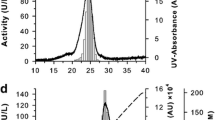Abstract
Studies on the extracellular enzymes ofCoriolus versicolor have resulted in the isolation and purification of several proteins that have the potential to act as redox enzymes.C. versicolor was cultured on a glucose-amino acid medium in a large-scale fermenter (60 L) with 2,5-xylidine added to induce the production of extracellular laccase. Proteins were precipitated from the growth medium with ammonium sulfate, and separated by ion-exchange chromatography on DEAE-Sephadex. Further separation of glycoproteins was achieved by affinity chromatography on Concanavalin-A-Sepharose. Polyacrylamide gel electrophoresis on SDS (sodium dodecyl sulfate) and LDS (lithium dodecyl sulfate) gels, isoelectric focusing, and chromatofocusing have been used to establish purity of the proteins and their isoelectric points.
Laccase B has been isolated and separated into five fractions by chromatofocusing, with isoelectric points of the fractions varying between pH 4.5 and 6.5. The relative specificity of these fractions towards monophenolic and diphenolic substrates has been investigated. Laccase A was found to differ from laccase B in showing only two bands on isoelectric focusing, with isoelectric points between pH 3.0 and 3.5.
Two other proteins isolated from the growth medium were both hemecontaining proteins with interesting spectral properties. One was a “peroxidasetype” heme that could bind carbon monoxide to the iron in the heme, suggesting that the heme may bind oxygen and so function as an oxidase. It reacted with hydrogen peroxide to liberate hydroxyl radicals, but this reaction with hydrogen peroxide resulted in the destruction of the heme center. The real role of this protein is unclear, but several possibilities will be investigated.
The second heme-containing protein isolated had different spectral properties from the “peroxidase-type” heme previously described. It had spectral characteristics of a b-type cytochrome in association with a flavin prosthetic group. It appeared to have some similarities to cellobiose oxidase, a heme flavoprotein previously isolated fromSporotrichum pulverulentum, although its molecular weight was 50,100 daltons compared with the 93,000 reported for cellobiose oxidase. Further characterization of this protein will be described.
Similar content being viewed by others
References
Ayers, A. R., Ayers, S. B., and Eriksson, K. E. (1978),Eur. J. Biochem. 90, 171.
Palmer, J. M., and Evans, C. S. (1983), Extracellular Enzymes Produced byCoriolus versicolor in Relationship to the Degradation of Lignin, inInternational Symposium on Wood and Pulping Chemistry, vol. 3, pp. 19–24 (Japan).
Author information
Authors and Affiliations
Rights and permissions
About this article
Cite this article
Evans, C.S., Palmer, J.M. Extracellular oxidases purified fromCoriolus versicolor . Appl Biochem Biotechnol 9, 353–354 (1984). https://doi.org/10.1007/BF02798972
Issue Date:
DOI: https://doi.org/10.1007/BF02798972




